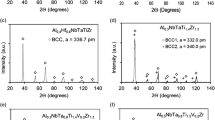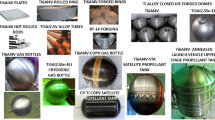It is shown that the structure of alloys based on titanium nickelide, obtained by industrial technology, invariably contains titanium-rich phases of type Ti2Ni/Ti4Ni2(O, N), even if the nickel concentration in the B2-phase exceeds the equiatomic composition. The volume fraction of these phases depends on the smelting method, the purity of the charge, and the technology used for subsequent ingot processing. Regression equations linking shape recovery temperatures with the concentration of nickel in the B2-phase in the quenched state are presented. On the basis of these equations, a method for calculating the volume fraction of Ti3Ni4 type particles released during aging is proposed.





Similar content being viewed by others
References
L. Lecce and A. Concilio, Shape Memory Alloy Engineering for Aerospace, Structural and Biomedical Applications, Elsevier Ltd (2015); DOI: https://doi.org/10.1016/C2012-0-07151-7.
O. Benefan, J. Brown, F. T. Calkins, P. Kumar, A. P. Stebner, T. L. Turner, R. Vaidyanathan, J. Webster, and M. L. Young, “Shape memory alloy actuator design: CASMART collaborative best practices and case studies,” Int. J. Mech. Mater. Des., No. 10, 1–42 (2014).
A. A. Ilyin, M. Yu. Kollerov, V. I. Khachin, and D. A. Gusev, “Medical instruments and implants of titanium nickelide: physical metallurgy, technology, and application,” Russ. Metall., No. 3, 296–300 (2002).
E. Lukina, M. Kollerov, J. Meswania, P. Panin, A. Khon, and G. Blunn, “The influence of TiN and DLC deposition on the wear resistance of Nitinol-Ti6Al4V combination for the medical application,” Mater. Today: Proc., 4, No. 3., 4675–4679 (2017).
J. Frenzel, E. P. George, A. Dlouhy, Ch. Somsen, M. F.-X. Wagner, and G. Eggeler, “Influence of Ni on martensitic phase transformations in NiTi shape memory alloys,” Acta Mater., 58, No. 9, 3444–3458 (2010).
J. Khalil-Allafia and B. Amin-Ahmadi, “The effect of chemical composition on enthalpy and entropy changes of martensitic transformations in binary NiTi shape memory alloys,” J. Alloys Comp., 487, 363–366 (2009).
K. Mehrabi, H. Bahmanpour, A. Shokuhfar, and A. Kneissl, “Influence of chemical composition and manufacturing conditions on properties of NiTi shape memory alloys,” Mater. Sci. and Eng. A., 481–482, 693–696 (2008).
S. M. Russell and A. R. Pelton, “Nitinol Melting and Fabrication,” Proceedings of SMST, 2000, (2000).
M. H. Elahinia, M. Hashemi, M. Tabesh, and S. B. Bhaduri, “Manufacturing and processing of NiTi implants: A review,” Prog. Mater. Sci., 57, 911–946 (2012).
D. E. Gusev, M. Yu. Kollerov, and A. A. Popov, “Effect of the volume fraction of Ti2Ni and aging on the structure and properties of alloys based on titanium nickelide,” Met. Sci. Heat Treat., 60, Is. 1-2, 72–79 (2018).
K. Otsuka and X. Ren, “Physical metallurgy of Ti–Ni-based shape memory alloys,” Prog. Mater. Sci., 50, No. 5, 511–678 (2005).
A. Coda, S. Zilio, D. Norwich, and F. Sczerzenie, “Characterization of Inclusions in VIM/VAR NiTi Alloys,” J. Mater. Eng. Perform., 21, 2572–2577 (2012).
A. Toro, F. Zhou, M. H. Wu, W. Van Geertruyden, and W. Z. Misiolek, “Characterization of non-metallic inclusions in superelastic NiTi tubes,” J. Mater. Eng. Perform., 18, 448–458 (2009).
A. I. Lotkov, S. Yu. Zavodchikov, V. A. Kotrekhov, V. N. Grishkov, N. V. Girsova, and V. N. Timkin, “Structure and martensitic transformations in titanium nickelide ingots obtained by vacuum induction melting with a cold crucible,” Persp. Mat., 1, No. 13 (Special edition), 31–42 (2011).
V. V. Tetyukhin, I. V. Levin, M. I. Musatov, I. Yu. Puzakov, S. M. Chechulin, and N. Yu. Tarenkova, “Skull melting as a promising method for the production of complex alloyed titanium alloys,” Tekh. Legk. Spl., No. 4, 7–12 (2007).
ASTM F2082/F2082M-16, Standard Test Method for Determination of Transformation Temperature of Nickel-Titanium Shape Memory Alloys by Bend and Free Recovery, ASTM International, West Conshohocken, PA, 2016; [electronic resource] www.astm.org (requested on 27.07.2020).
ASTM F2063–18, Standard Specification for Wrought Nickel-Titanium Shape Memory Alloys for Medical Devices and Surgical Implants, ASTM International, West Conshohocken, PA (2018); [electronic resource] www.astm.org (requested on 27.07.2020).
M. Yu. Kollerov, D. E. Gusev, A. A. Chernysheva, D. A. Lamzin, A. V. Matytsin, and S. I. Gurtovoy, “Influence of the chemical composition and volume fraction of the Ti2Ni intermetallic compound on the characteristics of the shape memory effect in alloys based on titanium nickelide,” Nauch. Trud. MATI, No. 11 (83), Moscow, Lamtec, 12–16 (2006).
M. Yu. Kollerov, D. E. Gusev, A. A. Chernyshova, S. I. Gurtovoy, and R. E. Vinogradov, “Influence of the content of nickel and impurities on the structure and temperature of the shape memory effect of alloys based on titanium nickelide,” Titan, 63, No. 1, 7–14 (2019).
G. R. Purdy and J. G. Parr, “A study of the titanium-nickel system between Ti2Ni and TiNi,” Trans. Metall. Soc. AIME, 221, 636–639 (1961).
A. A. Ilyin, Mechanism and Kinetics of Phase and Structural Transformations in Titanium Alloys, Moscow, Nauka (1994).
D. Holec, M. Friak, A. Dlouhy, and J. Neugebauer, “Ab initio study of point defects in NiTi-based alloys,” Phys. Rev. B, 89, 014110, 1–6 (2014).
J. M. Lu, Q. M. Hu, L. Wang, Y. J. Li, D. S. Xu, and R. Yang, “Point defects and their interaction in TiNi from first-principles calculations,” Phys. Rev. B, 75, 094108, 1–7 (2007).
X. Ren and K. Otsuka, “A unified model for point-defect formation in B2 intermetallic compounds,” Philos. Mag. A, 80, No. 2, 467–491 (2000).
G. Erdelyi, Z. Erdelyi, D. L. Beke, J. Bernardini, and C. Lexcellent, “Pressure dependence of Ni self-diffusion in NiTi,” Phys. Rev. B., 62, No. 17, 11284–11287 (2000).
Author information
Authors and Affiliations
Corresponding author
Additional information
Translated from Metallurg, Vol. 65, No. 1, pp. 84–92, January, 2021.
Rights and permissions
About this article
Cite this article
Kollerov, M.Y., Gusev, D.E., Sharonov, A.A. et al. Effect of Chemical Composition and Structure on the Shape Recovery Temperatures of Titanium Nickelide-Based Alloys. Metallurgist 65, 102–112 (2021). https://doi.org/10.1007/s11015-021-01137-6
Received:
Published:
Issue Date:
DOI: https://doi.org/10.1007/s11015-021-01137-6




